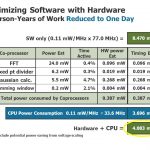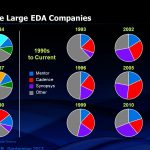Electronic design automation has evolved to an extent that the complex chips with tens of billions of transistors frequently produce first pass functional prototypes from the manufacturer. What makes this so incredible is that such a small portion of the possible states of electronic operation are actually tested in the simulation… Read More
Chapter Nine – Specialization Inhibits System Level Optimization
Solving critical customer problems sometimes isn’t enough. One of my most interesting experiences came during the development and rollout of a product that was designed to optimize integration of hardware and embedded software. In this case, the product performed exactly as planned but the plan ignored the organizational… Read More
Chapter 8 – Value Through Differentiation in Semiconductor Businesses
Gross Profit Margin Percent Provides a Measure of Product Value
The difference between what customers will pay for a physical product and what it costs to make or acquire it is a good measure of differentiation. This difference divided by the revenue is the gross profit margin percent or GPM%. Once a product has an established market… Read More
Chapter 7 – Competitive Dynamics in the Electronic Design Automation Industry
Electronic design automation, or EDA, became the term used for computer software and hardware developed to aid in the design and verification of electronics, from integrated circuits to printed circuit boards to the integrated electronics of large systems like planes, trains and cars. As the EDA industry evolved, certain … Read More
Chapter 6 – Specialization in the Semiconductor Industry
Recently, the combined market share of the top ten and top twenty semiconductor companies has been increasing, contrary to the trend of the last fifty years. Given the acceleration in mergers and acquisitions that began in 2015, one might assume that, as the semiconductor industry approaches maturity, companies are consolidating… Read More
Chapter 5 – Consolidation of the Semiconductor Industry
For the last decade, semiconductor industry analysts have been writing articles and giving presentations that predict the increasing consolidation of the industry to the point where a few large companies dominate worldwide sales of semiconductor components. In recent years there has been some justification for this view… Read More
Chapter 4 – Gompertz Predicts the Future
In 1825, Benjamin Gompertz proposed a mathematical model for time series that looks like an “S-curve”.1 Mathematically it is a double exponential (Figure 1) where y=a(exp(b(exp(-ct)))) where t is time and a, b and c are adjustable coefficients that modulate the steepness of the S-Curve. The Gompertz Curve has been used for a … Read More
Chapter 3 – Moore’s Law is Unconstitutional!
(Adapted from a presentation first given under this title in 1989 and subsequently expanded in presentations over a period of nearly thirty years)
In 1965, Gordon Moore, then R&D Manager for Fairchild Semiconductor, published a paper in “Electronics” magazine predicting the trend for semiconductors in the next ten years. … Read More
Chapter 2 – Constants of the Semiconductor Industry
In the mid 1980’s, Tommy George, then President of Motorola’s Semiconductor Sector, pointed out to me that the semiconductor revenue per unit area had been a constant throughout the history of the industry including the period when germanium transistors made up a large share of semiconductor revenue. I began tracking the numbers… Read More
Chapter 1 – Predicting Trends in the Semiconductor Industry
Figure 1 is the most basic of all the predictable parameters of the semiconductor industry, even more so than Moore’s Law. It is the learning curve for the transistor. Since 1954, the revenue per transistor (and presumably the cost per transistor, if we had the data from the manufacturers) has followed a highly predictable learning… Read More









TSMC N3 Process Technology Wiki